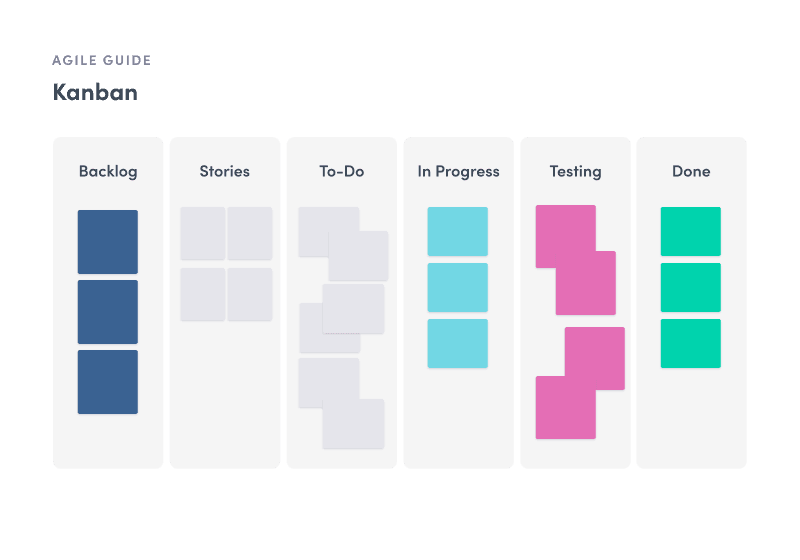Updated: April 10, 2025- 19 min read
When it comes to managing a product, different teams rely on different methodologies. Some swear by the structure of one method, while others embrace multiple. So, how do you know if the framework you're using is the right fit for your team?
In this article, we’ll lay out a comparative guide of different product management methodologies, weighing the whys and why-nots of each, taking into consideration the product lifecycle and the structure of the product team. Whether you're trying to validate the method you're currently using or contemplating a switch, this guide will give you the clarity you need to make the right call.
Product Strategy Template
The higher you go up on the Product career ladder, the more strategic skills matter. This template helps you define the why and how of product development and launch, allowing you to make better decisions for your users, team, and company.
Download Template
What Are Product Management Methodologies?
Product management methodologies are structured frameworks that guide product teams through the process of building, developing, and managing products from concept to market.
These methodologies provide the necessary steps, processes, and guidelines to ensure products are delivered on time, meet customer needs, and align with business goals. These methodologies — most of which we’ve listed in the product management frameworks piece — also help teams communicate, make decisions, and solve problems with a more structured and educated approach.
The Intention Behind Product Management Methodologies
Frameworks provide essential structure for problem-solving and decision-making in product management. They offer a systematic approach to addressing complex challenges and ensure alignment with strategic goals.
— Francois Ajenstat, Chief Product Officer at Amplitude, on The Product Podcast
The primary goal of product management methodologies is to streamline the product development process, ensuring that teams work in a structured, organized, and efficient manner.
Different methodologies emphasize various aspects of the development process, such as flexibility, planning, collaboration, or speed. The key intention is to balance constraints like time, resources, and customer requirements while delivering high-quality products that meet business objectives.
Key Concepts in Product Management Methodologies
Here are some of the core concepts you’ll find across different product management methodologies:
Process Structure: Each methodology provides a structured process or workflow that teams follow to move from product discovery to product launch. This process often includes stages like planning, design, development, testing, and launch.
Planning and Prioritization: Many methodologies emphasize different levels of planning, from product strategy and long-term roadmaps to short-term sprints. Prioritization frameworks help teams decide which features or tasks to tackle first based on customer needs, business goals, and technical feasibility.
Customer Focus: Successful methodologies ensure that the end-user or customer is at the center of the development process. This means using customer feedback loops, data, product metrics, and user stories to shape product features and improvements.
Flexibility vs. Structure: Some methodologies offer more flexibility, allowing teams to adapt and make changes as they go (e.g., Agile). Others follow a strict, linear process where each phase must be completed before the next begins (e.g., Waterfall).
Team Collaboration: Many methodologies focus on improving collaboration across departments, ensuring product managers, product designers, engineers, and stakeholders are aligned and working together smoothly. Regular communication, shared team goals, and team autonomy are often emphasized.
Continuous Improvement: A key principle in some methodologies is iterative development — releasing early versions of the product and continuously refining it based on feedback and product analytics. This is especially common in Agile-based approaches.
How To Pick Between 5 Core Product Development Methodologies
Choosing the right product management methodology is crucial for driving your product’s success. Below, we dive into five core methodologies — each with its unique focus, benefits, and challenges — to help you decide which best aligns with your company’s goals and product needs.

Agile: Flexible, Iterative Development for Rapid Change
Agile is a flexible, iterative approach to product management that focuses on delivering small, incremental updates rather than a single, final product. It’s designed to be highly adaptive — teams can respond quickly to changes and feedback.
Agile was created to help develop products more efficiently and flexibly. It’s purposefully built for environments where things change swiftly. It values customer collaboration, quick iterations, and responding to changes instead of following a strict plan.
Pros:
Fast iterations that allow for rapid adjustments – Agile teams can quickly implement feedback and improve the product continuously, which leads to fast product evolution.
Continuous customer feedback ensures the product aligns with user needs – Regular customer input ensures that the final product stays relevant and valuable to its intended audience.
Increased transparency and collaboration within teams – Teams work closely with stakeholders, ensuring all parties are in sync and aware of project progress.
Adaptability to evolving requirements – Teams can adjust priorities and features as market conditions or customer demands shift.
Cons:
Requires consistent stakeholder involvement, which can be time-consuming – Regular meetings with stakeholders can slow the process if they’re unavailable or decision-making is delayed.
Without a clear vision, frequent iterations may lead to scope creep – The lack of a fixed end goal can sometimes lead teams to expand beyond the original project scope.
Difficult to estimate timelines and costs due to its flexibility – The iterative nature makes it hard to predict exactly when a project will be completed and how much it will cost.
Agile is favored by companies that operate in fast-moving industries like software development, marketing, and IT. Startups and tech companies with evolving product features also benefit from Agile’s flexibility.

These are some of the popular companies using Agile:
Spotify - Music streaming industry
Spotify uses Agile to ensure rapid updates and feature releases. The method allows them to adapt quickly to user preferences in a fast-evolving digital field.Salesforce - Cloud computing and CRM software
Salesforce utilizes Agile to continuously roll out updates based on real-time customer feedback, keeping its CRM tools competitive and user-centric.Apple - Consumer electronics
Apple applies Agile in its software teams to quickly iterate and refine features. This way they ensure product launches are timely and aligned with customer expectations.Google - Search engine and digital services
Google adopts Agile to facilitate rapid experimentation and improvement across its platforms. This helps them maintain a high pace of innovation in search and digital services.
Spotify is a prime example of how Agile can transform product development. By using Agile methodologies, Spotify scaled rapidly while staying able to spark innovation and flexibility.
The company created “squads,” cross-functional teams that functioned as mini-startups, allowing them to release features quickly, test them, and adapt based on user feedback. This approach nudged Spotify to become a global leader in music streaming by continually optimizing its product.
Additional Insights: Taking Agile Further
While Agile in itself offers flexibility, it’s important to note that Agile isn’t just about going fast. It’s about continuous improvement and collaboration. Some additional tips for teams looking to deepen their Agile practice include:
Hybrid Approaches: Many companies now blend Agile with other methodologies like Waterfall or Lean to suit specific project phases. For example, companies might use Agile for feature development but revert to a more structured approach like Waterfall for initial planning.
Tools and Technology: Implementing Agile often requires specific tools to manage the process effectively. Tools like Jira, Airtable, Trello, and Asana allow teams to break down tasks, track progress, and make adjustments quickly. Selecting the right tools for your Agile workflow can make a significant difference in how well it’s executed.
Team Structure and Leadership: Agile works best when teams are self-organizing and empowered to make decisions. This doesn’t mean there’s no leadership. Strong leadership in Agile teams focuses on removing roadblocks and ensuring the team has everything they need to move fast. Managers in Agile teams should adopt a "servant leadership" approach to facilitate the team’s progress.
Cultural Shift: Agile transformation is more than just a process change — it’s a cultural one. Agile requires a mindset shift across the entire organization, where failure is seen as part of learning and where collaboration trumps hierarchy. Ensuring all team members, from developers to stakeholders, are on board with this mindset is critical for success.
Waterfall: Structured, Sequential Development for Predictability

Waterfall is a linear and sequential approach to product management — each phase must be completed before moving on to the next. It typically follows a structured flow from concept to completion, with minimal scope for change once the project begins.
Waterfall was designed for projects with well-defined requirements, with the goal of avoiding costly changes during the development process. It works best when product requirements are stable and unlikely to change during the project lifecycle.
While Waterfall can feel outdated in fast-moving industries, some sectors still vouch for it. Construction, healthcare, and even certain areas of automotive design (where safety regulations dominate) find it useful because predictability outweighs the need for flexibility.
Modern companies may blend elements of Waterfall with Agile (known as a "hybrid" approach) to maintain structure while adapting to change when necessary.
Pros:
Clear Structure: The linear approach of Waterfall provides a clear project roadmap, making it easy to follow. This is especially useful for long-term planning.
Easy to Manage: Since each phase has specific deliverables, it's easier to manage and monitor progress, which helps ensure that deadlines are met.
Comprehensive Documentation: Waterfall emphasizes thorough documentation, which is useful for knowledge transfer and future project reviews.
Better for Fixed Projects: Waterfall works well for projects with stable, well-defined requirements from the beginning, where changes are minimal.
Cons:
Inflexibility: Once a phase is completed, it’s challenging to go back and make changes. This makes Waterfall less suited for projects with evolving requirements.
Delayed Testing: Testing is done only after development. This means problems can surface late, potentially leading to costly fixes.
Longer Timelines: Since each phase must be completed before moving to the next, Waterfall can slow down delivery compared to iterative methodologies like Agile.
Limited Client Involvement: Customer feedback is often not incorporated until late in the process. This can result in a product that doesn't fully meet user needs.
When used in software development, Waterfall can backfire if initial requirements are misunderstood or change midway.
This can lead to significant rework since testing only happens after development. Companies adopting Waterfall for software often find themselves over budget or behind schedule due to the lack of flexibility. That's why Agile, with its iterative nature, has become the go-to in this field, as it allows for ongoing feedback and adjustments.
Popular companies using Waterfall:
NASA: NASA uses Waterfall for space projects due to its highly structured, linear approach, which ensures that all phases are carefully planned and tested.
Boeing: Boeing applies Waterfall for large-scale aviation projects, where rigid timelines and detailed documentation are critical for safety and compliance.
Department of Defense (USA): The U.S. Department of Defense prefers Waterfall for its strict project requirements and the need for meticulous documentation in defense projects.
Construction Industry: Construction companies often use Waterfall because of its clear, sequential project stages, making it ideal for physical infrastructure projects.
NASA has successfully used the Waterfall methodology in the development of its space programs, such as the Apollo missions.
Given the high level of complexity, regulatory requirements, and safety concerns, the predictability and control offered by Waterfall were crucial. NASA was able to manage and deliver highly complex systems by breaking the process into clear, manageable phases—each with strict completion criteria before moving to the next stage.
Scrum: Agile Product Methodology for Team-Based Collaboration

Scrum is a subset of Agile that focuses on team-based collaboration and breaking down tasks into small, manageable increments, known as “sprints.” Each sprint is typically 2-4 weeks long and delivers a potentially shippable product increment.
Scrum was created to provide a structured way to manage Agile projects with clear roles and processes. It ensures that teams stay focused and aligned on delivering continuous improvement through short development cycles.
Pros:
Quick Iterations: Scrum emphasizes short, time-boxed sprints, which allow teams to focus on delivering usable features quickly. This keeps the momentum going.
Adaptable: Scrum allows for frequent reassessment of priorities, so teams can pivot based on new information or feedback.
Improved Accountability: The daily Scrum meetings enhance team accountability by ensuring everyone is on the same page regarding tasks.
Strong Team Empowerment: Scrum empowers teams to self-organize, fostering ownership and creativity.
Cons:
Heavy Dependency on Team: Scrum's success relies on the whole team’s commitment and collaboration. If one team member isn’t pulling their weight, it affects the whole process.
Time-Consuming Meetings: Daily stand-ups, sprint planning, and retrospectives can be time-consuming and distract from actual development work.
Scope Creep: Without strong discipline, the flexibility of Scrum can lead to uncontrolled feature creep if new features are continuously added mid-sprint.
Needs Experienced Teams: Scrum requires teams that are skilled and self-managed, which can be a challenge for teams with less experience or weaker leadership.
Scrum is used by tech companies and any organization that values cross-functional teamwork, quick iterations, and high adaptability. It’s particularly popular in software development, product design, and marketing teams.
Popular companies using Scrum:
Amazon: Amazon applies Scrum to streamline operations and ensure quick delivery of new features, meeting fast-paced e-commerce demands.
ING Bank: ING Bank uses Scrum to drive innovation in financial services, ensuring agile development cycles to keep up with fintech demands.
3M: 3M uses Scrum in its innovation labs to rapidly prototype new products. It allows the company to stay ahead in the competitive manufacturing market.
Zappos: Zappos employs Scrum to enhance its customer service. It enables teams to quickly address user pain points and improve the online shopping experience.
Salesforce transitioned to Scrum as part of its Agile transformation to improve its product development process.
The company’s shift allowed them to speed up delivery times, increase collaboration across teams, and respond faster to customer feedback. The Scrum enabled Salesforce to roll out frequent updates and new features. This way they were able to boost user satisfaction and innovation in its CRM solutions.
Additional Insights
Tools and Software for Scrum: Jira is ideal for technical teams, offering detailed reports and DevOps integration. Trello works well for non-technical teams, focusing on visual task management, while Slack helps streamline daily communication during stand-ups.
Leadership and Team Dynamics: Scrum requires servant leadership, with the Scrum Master or Senior Product Manager facilitating rather than directing. A strong Product Owner is equally important — they need to bridge the gap between the team and stakeholders, ensuring the backlog is prioritized based on real user needs, not just what stakeholders think is important.
Hybrid Scrum Approaches: Scrumban blends the structure of Scrum with the flexibility of Kanban, perfect for teams managing both iterative work and ongoing tasks.
When to Use Scrum: Scrum is ideal for projects that evolve quickly, such as software development and marketing. However, if a project has fixed deadlines or well-defined requirements, more rigid methodologies like Waterfall may be a better fit.
Kanban: Visual Workflow Management for Continuous Delivery

Kanban is a visual workflow management methodology that focuses on continuous delivery without overburdening the development team. It uses a Kanban board to map out tasks, visualize the flow of work, and ensure that team members are focused on completing tasks before starting new ones.
Kanban was created to optimize efficiency by minimizing work in progress (WIP) and reducing bottlenecks in the workflow. It’s designed to improve process efficiency and encourage continuous improvement.
Pros:
Visual Workflow Management: Kanban’s visual board makes it easy to see the progress of tasks, helping teams identify bottlenecks quickly.
Continuous Delivery: Kanban allows for continuous work and delivery without the need for fixed sprints, which suit certain types of work.
Flexibility: There are no strict rules in Kanban. Teams can adopt the framework according to their specific needs and processes.
Limits Multitasking: By setting work-in-progress (WIP) limits, Kanban discourages multitasking and promotes focusing on completing tasks before starting new ones.
Cons:
Lack of Timeboxing: Without set timeframes like sprints, teams can lose urgency or focus, potentially delaying task completion.
No Defined Roles: Kanban doesn’t specify roles, so team organization can be inconsistent, making it harder for teams new to the framework to get started.
Overemphasis on Flow: The focus on continuous flow can sometimes mean less focus on long-term strategy or planning.
Potential for Scope Creep: Since Kanban doesn’t limit what can be added to the board, there’s a risk of continually adding tasks without a clear end goal.
Kanban is often used by teams that need to manage a high volume of incoming tasks, such as IT, customer support, and marketing teams. It’s also popular in industries like software development, healthcare, and manufacturing.
Popular companies using Kanban:
Toyota: Toyota pioneered Kanban in its manufacturing to reduce waste and improve efficiency, leading to leaner and more productive operations.
Dropbox: Dropbox uses Kanban to visually track tasks and maintain a steady flow in its software development.
Pixar: Pixar applies Kanban to organize and prioritize animation production tasks. This keeps creativity on track while meeting deadlines.
IBM: IBM uses Kanban to manage its IT service delivery. This allows them to reduce bottlenecks and prioritize tasks more effectively.
Toyota originally developed the Kanban methodology as part of its lean manufacturing system, known as the Toyota Production System.
By using Kanban cards to visualize the production workflow, Toyota was able to reduce waste, increase efficiency, and improve communication between teams. This approach revolutionized the automotive industry, turning Toyota into one of the most efficient manufacturers globally and leading to its dominance in the automotive market.
Additional Insights
Tools and Software for Kanban: Airtable, BusinessMap, and Asana are user-friendly Kanban tools, great for visual task management. For more advanced features like WIP limits and detailed product analytics, LeanKit and Jira provide more depth.
Leadership and Team Dynamics: Kanban doesn’t rely on rigid roles like Scrum. Teams are self-managing and focus on continuous improvement. Leadership's role is more about supporting flow and clearing obstacles rather than setting directives.
Hybrid Kanban Approaches: Some teams use Kanban within Scrum (Scrumban) to manage ongoing tasks while still delivering in sprints. This hybrid is popular for DevOps teams who need flexibility without sacrificing deadlines.
When to Use Kanban: Kanban shines when used by support teams, IT operations, and environments where priorities frequently shift but deadlines aren’t as rigid.
Lean: Efficiency and Waste Minimization for Maximum Value
Lean is a methodology focused on maximizing value while minimizing waste. It aims to deliver the highest possible value to customers with the fewest resources by streamlining processes, cutting waste, and improving efficiency.
The method was created as an approach to increase efficiency by eliminating unnecessary processes, delays, etc. It’s focus is to deliver the most value to customers. It prioritizes continuous improvement, flexibility, and the optimal use of resources.
Pros:
Waste Reduction: Lean focuses on minimizing waste in processes like unnecessary processes, tasks, and delays.
Customer-Centric: Lean ensures that every product feature or process adds value to the customer.
Quick Feedback Loops: Lean encourages fast feedback loops, allowing teams to iterate and improve quickly based on customer feedback.
Cost-Efficient: By focusing on the most value-adding activities, Lean helps reduce unnecessary costs and optimize resource usage.
Cons:
Requires Cultural Shift: Implementing Lean requires a company-wide cultural shift, which can be challenging and time-consuming to achieve.
Risk of Over-Focus on Short-Term Gains: Lean’s focus on waste reduction might lead teams to cut corners or underinvest in longer-term strategies.
Heavy Reliance on Metrics: Lean relies on continuous data analysis, and without strong data, decision-making can become skewed.
Difficult to Scale: While Lean works well for small, focused teams, scaling Lean practices in large organizations can be complicated without clear communication and alignment.
Lean is commonly used in industries where efficiency and process optimization are crucial, such as manufacturing, healthcare, and software development. It’s also popular in startups aiming to develop products quickly while minimizing costs.
Popular companies using Lean:
Intel
Intel applies Lean in its production facilities to reduce costs and streamline chip manufacturing, enabling faster product delivery.Nike
Nike uses Lean to optimize its supply chain, focusing on waste reduction and efficiency, resulting in more sustainable production.Ericsson
Ericsson incorporates Lean to improve efficiency in its telecommunications operations, ensuring faster time-to-market for its tech products.Ford
Ford leverages Lean principles to streamline its car manufacturing processes, reducing waste and improving operational efficiency.John Deere
John Deere employs Lean to optimize its agricultural equipment manufacturing, focusing on minimizing waste while enhancing product quality.
Nike successfully implemented Lean principles in its manufacturing process to reduce waste and increase efficiency.
By adopting Lean, Nike was able to cut down on material waste, speed up production times, and significantly reduce the time-to-market for new product launches. Lean’s focus on continuous improvement and eliminating inefficiencies helped Nike maintain its position as a global leader in the athletic apparel industry.
Additional Insights
Tools and Software for Lean: Miro and Lucidchart are useful for mapping out processes and identifying inefficiencies in real time.
Leadership and Team Dynamics: In Lean, leaders focus on empowering teams to continuously improve processes and eliminate waste. Teams are encouraged to make decisions based on data and customer value, fostering a collaborative and problem-solving environment.
Hybrid Lean Approaches: Combining Lean with Agile is popular in software development. Teams use Lean principles to streamline processes while maintaining Agile’s flexibility for responding to change, optimizing both efficiency and adaptability.
When to Use Lean: Lean is ideal for companies that need to focus on efficiency, cost-saving, and reducing waste, such as manufacturing, healthcare, or any company looking to improve process flows without compromising quality. It works well in large organizations aiming for operational excellence.
Choosing Wisely: Product Management Methods That Fit Your Workflow
Each methodology, whether it’s Agile’s flexibility or Waterfall’s structured approach, brings unique strengths to the table. The key is to ask the right questions: Do we need to iterate fast, or do we need strict, predictable outcomes? Are we prioritizing collaboration, or is process control more crucial?
Ultimately, the best choice is one that aligns with both your product's lifecycle and your team's workflow.
Don't be afraid to blend methodologies or adjust as your company evolves. The smartest decision is always informed by your specific context — so take time, involve your team, and choose wisely. The right methodology can streamline your processes, but only if it truly fits the way you work.
Enroll in Product School's Product Strategy Micro-Certification (PSC)™️
The difference between a good and a great product lies in your Product Strategy, answering vital questions like: Who's the product for? What benefits does it offer? How does it further company objectives?
Enroll for Free
Updated: April 10, 2025





